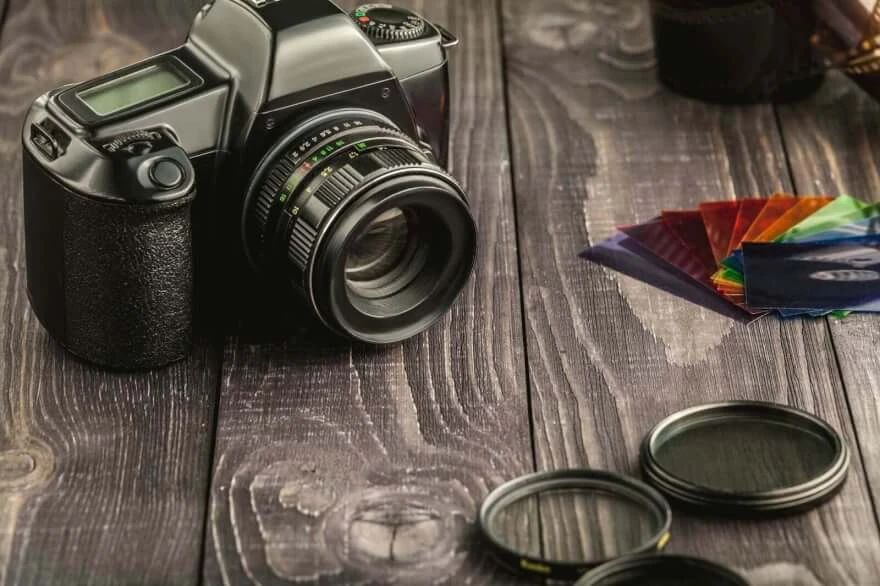8 Best camera filters for beautiful effects

- General information about the filters and wavelengths
- UV Filter
- Polarizing Filters
- Circular Polarizing Filter (CPL)
- Neutral Density (ND) Filter
- Graduated ND Filter
- Color Filters
- Color Graduated Filters
- Star Filter
- Soft-Focus Filter
- Infrared (IR) Filter
- Close-Up Filter (Macro Filter)
- Creative Effects Filters
- Conclusion
Many beginner photographers are intimidated by lens filters and they do not understand their value. Filters can be seen as a kind of extra accessory that you do not really need, but that could not be further from the truth. Camera lens filters are the game-changing piece of equipment in overall photography gear. Camera filters play a key part in not just protecting your gear but also improving the quality of your content and at the same time allowing for cool and beautiful effects that you will not be able to do otherwise. Today we are going to talk about different types of filters and the three main types are UV, Polarizing, and ND filters would be our main subject. We will also do a quick look at the other types of filters so that you understand their specifics in general.
General information about the filters and wavelengths
Lens filters come in various sizes to match your lens dimensions accordingly. You have to purchase a lens filter that is exact same size as the glass on your lens. In order to find how large that is on your camera lens you can read the numbers that are around the lens rim which is shown in millimeters, and this is how you know which filter is going to fit your lens. There are also two adjustment types for filters as well, as they could be flexible or fixed so that you either replace filters for each shot or buy a flexible one that has an adjustment rim on it. Besides the adjustment types, filters serve to reduce or filter out certain wavelengths of light.

- X-rays are of 0.01 nm – 10 nm.
- Ultra Violet 10-380 nm
- Visible light is 380-780 nm.
- Infrared Light 780 nm - 0.3 mm
- Microwaves are of 1 mm - 10 cm.

The longer the wavelength the more color we lose and we get black and white photos after reaching 900 nm of the wavelength. We are going to review the ways to filter certain wavelengths going from UV to IR spectrum including visible light to achieve different effects in our shots. Therefore we have a large variety of filters to cover any needs in photography. Now let us break it down for each type of filter and see how they work.
UV Filter

A UV Filter is a must-have for any photographer and videographer even as a beginner. As you first look at a UV Filter, you will notice it looks like a completely transparent glass. Its main purpose comes from its name means to reduce or prevent UV rays from hitting the sensor of your camera. As a result, it reduces the haziness or bluish cast in your photo or video.
Besides actual UV prevention, it serves as physical protection for your lens, as if you drop it by accident, a broken filter is not such big of a deal compared to a new lens purchase if you break it.

Polarizing Filters

When you first hear the term polarizing filter, the first thing that comes to mind is sunglasses, and in reality, this type of filter has a similar effect. It is essential for landscape photography and any other types of outdoor photography as it makes your colors much more vibrant and reduces reflections that may come from the natural environment such as water for instance. Blues in your sky are going to pop with this filter and greens from grass will outstand as well. Once you have framed your shot you just screw the polarizing filter on and twist it around until you start to see those colors come vibrant and the reflections are cutting back, hence you get the full effect from this filter.
Circular Polarizing Filter (CPL)

CIrcilar polarizers (CPL) remove reflections from the surface of an object which works not only for portrait photography but also for product, automotive, and even landscape photography to remove reflections from water or to make trees look more saturated. The difference between linear (normal) polarizing filters and CPL ones is that linear polarizers only allow for horizontal or vertical light waves to enter. Circular ones relate to waves that are going in a circular direction. Circular filters work despite the way you attach them to your camera, whereas linear ones work only one way toward the camera lens. CPL filters are versatile and work on most cameras, while linear will not see use on DSLR cameras as they will interfere with its lens metering system. Linear polarizers cause autofocus issues, especially on wide-angle lenses. As for practical usage, a linear polarizer eliminates water and glass reflections. Circular ones will do the same, plus have a use for metal reflections as well, and this is why CPL filters have a common use in automotive photography. So, you may choose one over another depending on which reflection you want to get rid of and which one to let through.
Neutral Density (ND) Filter

The purpose of a neutral density ND Filter is to reduce the amount of light that is being led into your lens live into your image. It is essential for video because you need to keep your shutter speed at a certain number and if you are shooting 24 frames per second that is going to be 1 over 50. So that, when you are shooting on a super bright day you need one of these ND filters to carry as they will cut down the amount of light being led into your camera and maintain your required shutter speed. ND filters vary in levels of light reduction and that correlates to a number on the filter itself. Usually, after you see ND written on the rim of the filter, this means the reduction level by a number that is presented on the rim. For instance, ND8 means it is going to reduce the light ⅛. So the lower the number of the ND filter, the more light is being reduced. Hence ¼ is more light going through the filter than ⅛. You can have fixed or different amounts of light reduction depending on your filter. If it is variable, then you can just turn the filter around to make it different levels of reduction, which is valuable if you do not consider changing your filters on the go. As we mentioned earlier, ND filters are good for videography, but if you are shooting some sunset photos and you want to get long exposure of water or clouds moving you have to lower your shutter, but you can not do that because you are letting in tons of light and there is still a lot of light outside. Pop on an ND filter and that allows you to reduce your shutter speed and take that long exposure photos.

Graduated ND Filter
Graduated neutral density or Grad ND for short serves the same purpose as normal ND filters to reduce the amount of light in the lens but with the addition of the dynamic range it covers. For example, if you are shooting landscape and notice that the sky is overexposed, here is why you need a Grad ND filter to fix this. The reason why we often experience overexposed skies is because of dynamic range or lack thereof. Simplified, dynamic range is the defined ratio between the darkest and lightest values that your camera can register. The greater the dynamic range, the further we can reach into both the shadows and the highlights to retain detail. Take a camera with great dynamic range and raw and there is a fair bit of leeway to take a seemingly overexposed shot and display the data retained within the raw values of the image. You can of course fix highlights and shadows with powerful digital cameras or even in the post, but ND filters make that simple workflow without additional crutch measures. Besides, using digital filters whether in your camera settings or Lightroom will reduce the amount of data coming from the raw image and you lose details in specific colors and outlines that may cast the highlights over the shadows naturally. This is why Grad NDs are essential for exposing the horizon in landscape photography.
Color Filters

Color filters' purpose obviously comes from the name as they serve to filter out or add a certain color range to a specific photograph. You may think, why would I choose to shoot in red, and the reason is that when you do black and white photography, the red color filter will reduce the amount of light that comes from the sky and make it look darker in B&W or Monochrome spectrum where red color is completely neglected. This will allow you to spend a lot less time in front of your computer editing this type of photo in post. Each color could affect your image in different ways, so that, with a green filter you will make trees go lighter, and a red filter to make blues darker. So the general purpose of raw color filters has an application in monochrome or black-and-white photography.
Color Graduated Filters

Color filters are also available in color-graded versions. Graduated color filters are half-colored and have a smooth transition from color to transparency across the glass surface.
If you need to filter a specific area in a photo, such as the sky, you should use graduated color filters.
Star Filter

Star filters have a grid applied on their surface in a specific pattern which causes the light going through to split and make for a star or flare effect. Hence, its main purpose is to make any light to produce rays like stars. There are a variety that means to produce different numbers of rays. Eight is a very common usage as it makes it look more natural compared to some 4-ray star filters. This effect has no means of reducing quality or spoiling the image in any way. If you want to give your specific photos more spice and personality, star filters are the way to get that flare effect.
Soft-Focus Filter
If you have an old camera such as a Nikon D5100 or D3200 you may notice that the image they produce with their profile is oversharpened. Soft-focus filters serve to make images softer and they have a softness range that produces different levels of image blurring effect via spherical aberration. So that you can use these types of filters in order to have a nice and smooth edge or outline bokeh on your photos.
Infrared (IR) Filter

As we have mentioned in general filter information, visible light comes in a wavelength of a certain size, which starts from 380 nm. IR filters serve the purpose of blocking any visible light and allow you to shoot in an infrared spectrum of 590 mm wavelength and higher to desaturate colors in a specific way. We need to shoot in long exposure to make the IR filter work which allows any camera to do IR photos. It is a unique experience, and this is why IR photography is a niche that exists in the first place. You don’t have to buy a specific IR camera with a built-in filter and use an attachable IR filter instead which you can use even on a phone camera.
Close-Up Filter (Macro Filter)

Close-up filters reduce the focal length of the lens which makes it for macro photography purposes. This allows you to keep your lens extension and not spend on purchasing a telephoto lens for Marco. So it is basically a magnification glass that allows you to do macro without getting distorted images.
Creative Effects Filters
To achieve some creative effects besides the mentioned ones you can go for specific filters that come in shapes to make for various effects like focus stacking or the opposite image distortion. For instance, a linear prism camera filter is to make an image split into multiple ones. Griffin fog filters to produce fog of the light in the image. Motion filter to get motion effect. Dream mist filter makes the light look a bit blurred out which is sort of opposite to the star effect and holds the light in place giving it a smooth outline of the mist. Allure Streak blue filter that works like a star filter but pops blue light rays more.

Conclusion
Filters may make a significant difference in how your image looks like. Some filters, like IR or Marcro, have a niche in specific photography types and other filters are to improve your image quality by working with shadows and highlights through the exposure and shutter speed setup.
Before buying a filter of your choice, make sure that your camera lens has filter threads on it. As we mentioned earlier, the lenses are of a different size and require a match for ND filter dimensions as well. Make sure to have a variety that comes in either flexible filters with a rim adjustment or a package of replaceable filters for the fixed effect of your choice. You can also go in the way of buying the largest size filter that matches your largest lens and applying the step-up/down attachment rings to adapt filters of a smaller size to your smaller lenses.
Co-founder of RetouchMe. In addition to business, he is passionate about travel photography and videography. His photos can be viewed on Instagram (over 1 million followers), and his films can be found on his YouTube channel.
Moreover, his profile is featured on the most popular and authoritative resource in the film industry — IMDb. He has received 51 international awards and 18 nominations at film festivals worldwide.

with RetouchMe














